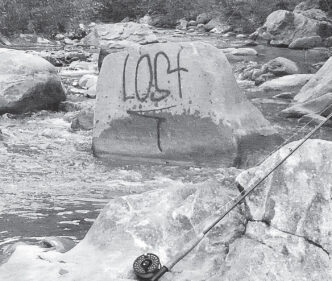There’s a crayfish somewhere in my office. She apparently crawled up the air tube of her aquarium and escaped over the glass walls sometime in the night. She is probably hidden in a nook and looking at me right now with her stalked eyeballs as she probes the air with her antennae, searching for the smell of water. She is dying for lack of water, and unless I can find her soon with my eyes, I will find her later with my nose. Lately, my nose has been overwhelmed by crayfish. Even live ones stink.
Crayfish eat just about anything, but they don’t eat it well. Instead of simply taking a bite of food and swallowing it, a crayfish rolls and pinches and passes the food item between each of its small claws. Crayfish, of course, have the two obvious “pinchers” they wave above their head at the first sign of danger, but they also have small pinchers on the next two pair of legs, and they use these to explore their environment and to play with their food. Despite a sparse regime of “crab chow,” the two crayfish in the 20-gallon tank in my office require a daily 5-gallon water exchange and a weekly filter replacement to keep the water clear and relatively odorless. The species known as signal crayfish (Pacifastacus leniusculus) was introduced into Lake Tahoe in the early 1900s as a source of food for both trout and the local populace. The crayfish population steadily grew to about fifty-six million in the 1960s. In the mid-1970s, I worked with the California Department of Fish and Game doing fish surveys throughout the Truckee watershed, and stomach analyses showed that crayfish were being eaten by all but the smallest trout, and in the rivers, at least, the majority of fish that held food in their guts contained some telltale trace of the crustacean. At that time, there were probably one hundred million crayfish in Tahoe. By the year 2000, the population had doubled to over two hundred million and blew by the three hundred million mark some 15 years later. At this point, they don’t appear to be encountering any factors that might temper the rate of their population growth.
Lake Tahoe is admittedly larger than any fish tank, but if two four-inch crayfish can completely foul a 20-gallon aquarium in less than a week, it seems that three hundred million of them would have some sort of effect on the quality of Lake Tahoe and its outflow, the Truckee River. And it appears they do.
Crayfish not only foul their water by playing with their food, they also defecate large amounts of nutrient and incessantly dig the substrate, introducing fixed minerals back into the water. All of this contributes to Lake Tahoe’s decline in water clarity. According to University of Nevada Reno scientist Sudap Chandra, some of Tahoe’s macroinvertebrate populations have fallen 99.9 percent since the 1960s, and crayfish are the prime suspects. Not only do crayfish eat the macroinvertebrates themselves, they also eat the plants on which the macroinvertebrates depend.
We could drum the crayfish-related bad news all day, but instead, let’s look at the silver lining. Trout grow quickly on a diet of crayfish. They apparently love to eat them, and they are usually eager to eat crayfish imitations . . . but only if served just right.
Crayfish lend themselves to intricate imitations with lots of detail. Eyes, legs, antennae, tail, and jointed body parts are all often replicated at the tying desk or added to create bin appeal and catch anglers. The most common adornment is a pair of large pinchers. They look nice and “match the hatch,” but unfortunately, one of the last things a fish wants to face is a pair of claws.
Pure Fishing is a massive conglomerate that includes Abu Garcia, Berkley, Stren, PENN, Fenwick, Hardy, Greys, and many other fishing companies. It is estimated that out of every fishing dollar spent, 20 cents goes to Pure Fishing. Pure Fishing has a heavily vested interest in making certain that fish want to eat their baits, are attracted to their lures, and are seduced by their scents. Unlike fly fishers, who design and fish patterns based on whims and anecdotal evidence, Pure Fishing invests millions of dollars teasing out the finest details of fish behavior and of attraction triggers, based on feedback from angling pros backed by rigorous scientific observation.
One such study was done on bass and their reaction to crayfish. Over two months, 450 bass were presented with various versions of crayfish. Not entirely surprisingly, bass preferred crayfish with no claws over those with claws. But even more desirable by a majority of the bass were crayfish with no claws or legs. The preferred prey was something that looked like a prawn. The resulting lure from this research became the Berkley Power Bait Flippin’ Tube. It was an overnight success in terms of catching fish, but despite the research and catch statistics, the lure-buying public still insisted it have something that resembled claws.
In the fly-fishing world, a Flippin’ Tube looks like a Woolly Bugger without hackle. Additional research suggests that bass prefer a two-to-four-inch crayfish and that color choice is highly variable and not very predictable. Dr. Keith Jones, who is a chief researcher for Pure Fishing, believes that contrast against the ambient environment is more important than the actual color itself.
I can’t say for certain that trout have the same attraction for legless, clawless, contrasty crayfish that bass do, but common sense would suggest that they would be more inclined to follow the traits of another fish than the whims of a human fly tyer.
There have been crayfish stinking up my office for nearly four months. I’m not particularly fond of them, and keeping them happy, healthy, and clean has been a chore. The sole purpose of maintaining these captives has been to observe them molt. Common fly-fishing lore has it that fall is “molting season,” when in actuality, a crayfish molts whenever it outgrows its shell, which can be as frequently as eight or more times in a year. If the water is warm enough, it is always molting season when you’re a crayfish. Before the water temperature drops much below 50 degrees in the fall, crayfish spawn. The males, which are normally shy of light and stay hidden during the day, will be on the prowl in open water as they search for mates. During a season when the nymphs of most aquatic insects are small and not emerging or are not otherwise making themselves vulnerable to trout, crayfish become choice and easy targets. Fall is indeed prime crayfish season, but that has nothing to do with molting.
During low winter temperatures, crayfish metabolism drops, and they remain largely hidden in burrows or deep under boulders. In the spring, when water temperatures once again approach 50 degrees, mating resumes, and once again the males are vulnerable to predation, but in much lower numbers than in the fall, because of overwintering mortality. Once mating is over, within a month or so, both male and female crayfish become largely crepuscular and avoid clear and shallow waters during daylight hours.
Freshly molted crayfish are commonly known as “soft shells.” The shells are the consistency of a bicycle inner tube, and the entire crayfish is as pliable as an Easter Peep. When given a gentle pinch, and I mean very gentle, a molted crayfish exudes an orange fluid and dies shortly thereafter. It’s hard to believe than many crayfish survive this interlude. Fishing experts agree that given the choice, fish will choose to eat soft shells above any other crayfish.
The first few hours after molt are critical in a crayfish’s survival. They don’t have the structural integrity to walk, much less swim. Any shift of their protective cobbles will send them helplessly into the drift. “Dead drift” is an apt description for this hapless event, as well as the method fly anglers should employ when presenting a soft-shell crayfish imitation. Despite the fact that in a lifetime of swimming in crayfish-rich environments I’ve never seen a gray crayfish, every softshell fly pattern I’ve ever seen is pale gray. Crayfish come in shades of blue, green, brown and orange . . . why are the patterns gray? Because people like me were told that, believed it, and spread the word.
Guilty as charged.
After nearly forty years of observing every color crayfish but gray, I decided to raise a few and see these mysterious gray soft shells for myself. The ochre, coffee-ground color of the signal crayfish in our aquarium transformed into a translucent, brilliant orange following molting. Even the eyes went from black to orange. Its buddy, a darker, blue-green crayfish, also emerged from its shell as a salmon-egg orange creature. It took the crustaceans about two weeks to regain their original color. I understand that not all crayfish look the same, but I’ll never tie another gray one again.
















